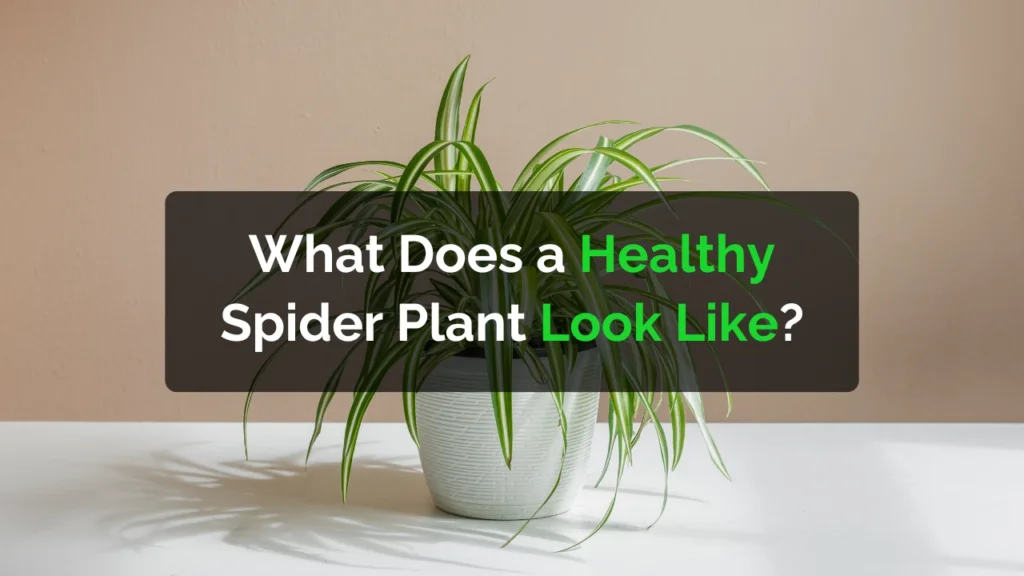Spider plants (Chlorophytum comosum) are one of the most popular houseplants because they are easy to care for, resilient, and look beautiful in any indoor setting. But if you’re new to growing them, you might wonder: What does a healthy spider plant actually look like? Knowing the signs of a thriving plant will help you care for it better and spot problems before they become serious.
Signs of a Healthy Spider Plant
A healthy spider plant shows clear visual and growth signs that indicate it’s thriving. Here’s what to look for:
1. Bright Green, Arching Leaves
The leaves of a healthy spider plant are long, narrow, and arch gracefully outward. Depending on the variety, they can be solid green or have creamy-white stripes down the middle or edges. The color should be vibrant and rich (dull or yellow leaves) may indicate stress or nutrient deficiency.
2. Strong and Firm Foliage
When you touch the leaves, they should feel firm and sturdy, not soft or limp. Firm leaves are a sign that your plant is well-hydrated and getting the right amount of light.
3. New Growth and Spiderettes
One of the clearest signs of a healthy spider plant is continuous new growth. Look for small shoots or baby plants (often called spiderettes or plantlets) dangling from the mother plant. Producing spiderettes means the plant is mature and thriving.
4. White Flowers in the Right Season
Healthy spider plants often bloom small white flowers on long stems before producing spiderettes. These delicate flowers are another sign that your plant is getting enough light and nutrients.
5. No Browning or Yellowing Tips
While occasional brown tips can happen due to tap water or low humidity, a healthy spider plant should have minimal browning. If the majority of leaves are green and vibrant with only a few minor blemishes, your plant is doing well.
6. Root Health
If you take the plant out of its pot, the roots of a healthy spider plant should be white and firm, not mushy or brown. Over time, the roots may fill the pot, which is a sign it’s ready for repotting, not a sign of poor health.
What Does an Unhealthy Spider Plant Look Like?
To keep your plant thriving, it helps to recognize the signs of poor health. An unhealthy spider plant may show:
- Yellow or pale leaves – could be caused by lack of nutrients or insufficient light.
- Brown, crispy tips – often from fluoride or chlorine in tap water, low humidity, or underwatering.
- Drooping or limp leaves – usually a result of overwatering or poor drainage.
- Root rot – roots appear mushy, black, or foul-smelling, a clear sign of too much water.
- Stunted growth – no new leaves or spiderettes, often due to low light, poor soil, or neglect.
Common Care Mistakes to Watch Out For
Spider plants are forgiving, but overwatering and underwatering are the most common issues. Both can cause leaves to lose their healthy green appearance.
Overwatered Spider Plant Signs
- Leaves turning soft and mushy
- Foul smell from the soil
- Yellowing starting at the base
Underwatered Spider Plant Signs
- Dry, crispy leaf tips
- Soil pulling away from the sides of the pot
- Drooping leaves that perk up after watering
How to Keep a Spider Plant Healthy
- Watering: Water when the top inch of soil feels dry. Avoid soggy soil.
- Light: Place in bright, indirect sunlight. Direct sun can scorch the leaves.
- Soil: Use a well-draining potting mix.
- Humidity: Moderate indoor humidity is enough, but occasional misting helps.
- Fertilizer: Feed monthly during spring and summer with a balanced houseplant fertilizer.
- Repotting: Repot every 1–2 years when the roots outgrow the pot.
FAQs
How do I know if my spider plant is healthy?
A healthy spider plant has bright green, arching leaves, firm foliage, and shows new growth. It may produce spiderettes and occasionally small white flowers.
What does an unhealthy spider plant look like?
An unhealthy plant may have yellow or brown leaves, drooping foliage, or signs of root rot. Stunted growth and dry, crispy tips are also indicators of stress.
How to tell if a spider plant is over or underwatered?
Overwatered plants have soft, yellow leaves and soggy soil, sometimes with root rot. Underwatered plants show dry, crispy tips and drooping leaves that recover quickly after watering.
How often should I water a spider plant?
On average, water once a week during the growing season and less in winter. Always check the soil first, water only when the top inch feels dry.





